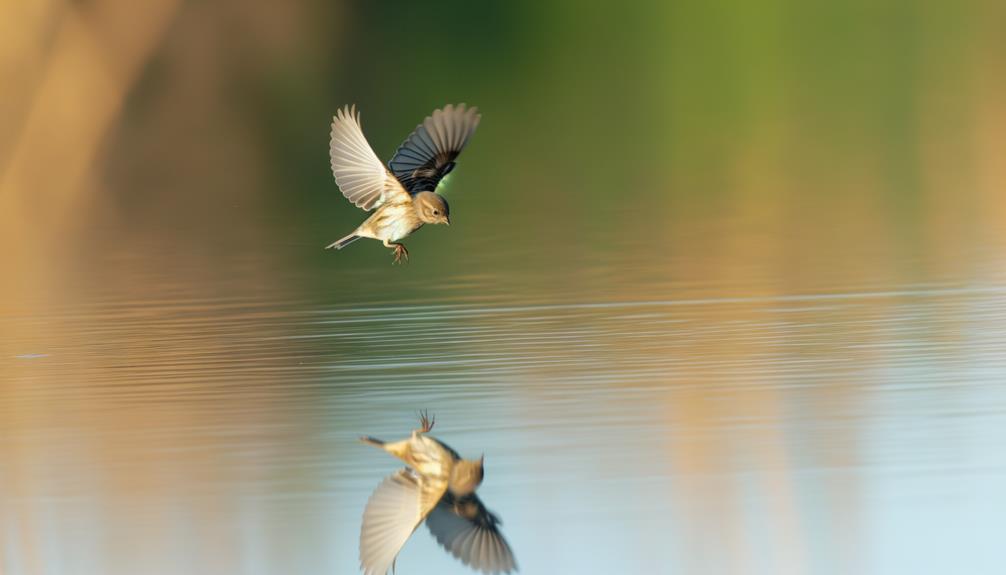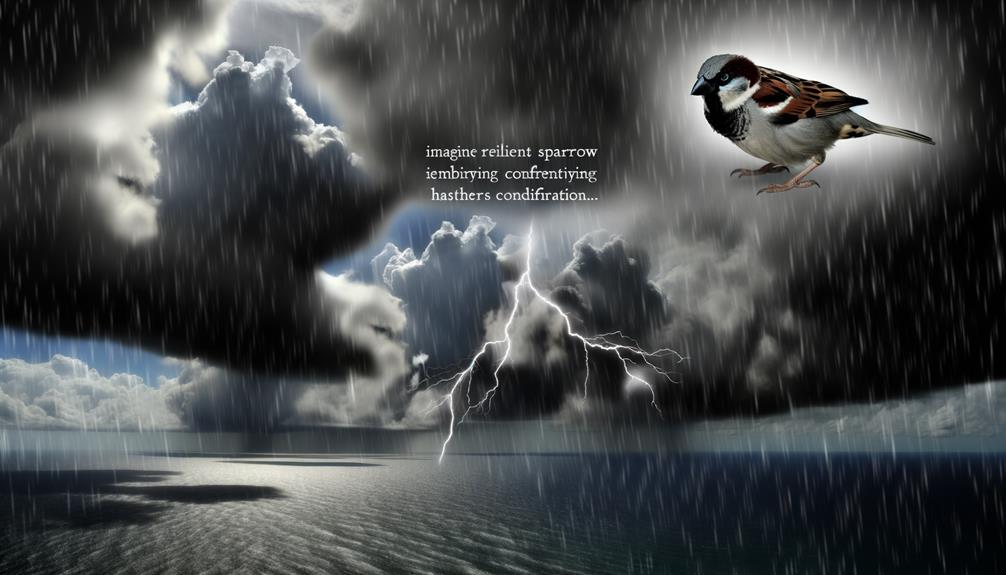How Sparrows Fly Across Water
Sparrows, characterized by short, rounded wings and strong flight muscles, can certainly fly over water bodies, although they usually excel in shorter, nimble flights. Their light skeletal structure and effective respiratory systems support continuous flapping flight, allowing for short water crossings.
However, crossing large bodies of water such as oceans can present significant challenges due to increased energy consumption and harsh weather conditions. Smaller water bodies, like lakes and rivers, may be crossed more easily with the help of favorable winds.
Explore factors such as migratory patterns, energy efficiency, and environmental impacts to gain a deeper understanding of their capabilities.

Key Takeaways
- Sparrows excel in short, agile flights and typically avoid prolonged journeys over large water bodies.
- Favorable wind conditions aid sparrows in crossing smaller water bodies like rivers and ponds.
- Sparrows optimize lift and energy use through wing flapping and feather arrangement for efficient short-distance flights.
- Rest stops in coastal regions are crucial for sparrows during migrations over water bodies.
- Adverse weather and insufficient food resources can prevent successful long-distance water crossings for sparrows.
Sparrow Flight Mechanics

Understanding sparrow flight mechanics requires a detailed examination of their wing structure, muscle distribution, and aerodynamic capabilities. Sparrows possess relatively short, rounded wings which facilitate rapid takeoffs and high maneuverability, essential for evading predators and traversing dense vegetation.
Their flight muscles, particularly the pectoralis major and supracoracoideus, are highly developed, enabling sustained flapping flight. Aerodynamically, sparrows generate lift through a combination of wing flapping and precise feather arrangement, optimizing airflow and minimizing drag.
The morphological adaptations, including a lightweight skeletal structure and efficient respiratory system, further enhance their flight efficiency. These factors collectively enable sparrows to execute complex flight patterns, though their endurance is generally tailored to short, agile flights rather than prolonged journeys over extensive bodies of water.
Types of Water Bodies
The various types of water bodies, ranging from small ponds to vast oceans, present distinct ecological and physical challenges that influence avian flight patterns and behaviors. Each water body varies in size, salinity, and surrounding vegetation, factors critical to avian navigation and foraging strategies.
| Water Body | Size Range | Key Characteristics |
|---|---|---|
| Pond | < 0.1 km² | Freshwater, surrounded by vegetation |
| Lake | 0.1 – 100 km² | Freshwater, varying depths, minimal salinity |
| River | Varies | Flowing freshwater, variable flow rates |
| Sea | 100 – 1,000 km² | Saline, affected by tides and currents |
| Ocean | > 1,000 km² | Highly saline, large waves, strong winds |
Understanding these parameters is essential for comprehending how sparrows navigate and survive across different aquatic landscapes.
Energy Expenditure

Energy expenditure in sparrows during flight across water bodies is influenced by multiple factors, including distance, wind conditions, and available food resources.
The metabolic rate of sparrows significantly increases with the duration and intensity of flight, necessitating efficient energy utilization. Adverse wind conditions can exacerbate the energy required, as sparrows must exert more effort to maintain flight stability and direction.
Additionally, the availability of food resources prior to and during the journey is pivotal; insufficient energy reserves can lead to exhaustion, reducing the likelihood of successful transit. Studies indicate that sparrows optimize their flight paths to minimize energy expenditure, often utilizing wind currents favorably.
Understanding these energy dynamics is crucial for comprehending sparrow flight capacity across aquatic expanses.
Migratory Patterns
The migratory patterns of sparrows involve complex seasonal flight paths that often span significant geographic distances.
During these cross-continental journeys, sparrows strategically utilize rest stops, which are essential for recuperation and survival.
Analyzing these patterns offers insight into the species' adaptive behaviors and environmental dependencies.
Seasonal Flight Paths
How do sparrows navigate their complex migratory routes across vast bodies of water?
Seasonal flight paths are essential to the survival of sparrows, relying on an interplay of innate biological mechanisms and environmental cues. Sparrows utilize a combination of the Earth's magnetic field, the position of the sun, and even star patterns to orient themselves.
Their endogenous circadian rhythms play a pivotal role in timing these migrations to coincide with best weather conditions and food availability. Additionally, recent studies suggest sparrows may possess an intrinsic 'map sense' enabling them to correct course deviations caused by winds or storms.
Understanding these intricate navigational strategies not only illuminates avian migration but also provides broader insights into animal behavior and ecological adaptation.
Cross-continental Journeys
Crossing transcontinental journeys, sparrows exhibit remarkable endurance and precision, leveraging a suite of physiological adaptations and environmental cues to traverse thousands of miles. Their migratory routes are influenced by innate genetic programming and learned behaviors, ensuring best-suited paths that maximize survival rates.
Key physiological adaptations include increased fat reserves, efficient muscle function, and enhanced cardiovascular capacity, enabling sustained flight over vast distances. Environmental cues such as geomagnetic fields, polarized light patterns, and star navigation play critical roles in orientation and navigation.
These birds also exhibit phenotypic flexibility, adjusting their metabolic rates and wing morphology to meet the demands of long-distance travel. The integration of these factors underscores the sparrow's capacity for transcontinental migration, highlighting their evolutionary ingenuity.
Rest Stops Locations
Identifying best rest stop locations is crucial for sparrows during their migratory journeys, as these sites provide essential resources and recovery time needed to complete their transcontinental flights.
These stopovers offer critical access to food, water, and shelter, enabling sparrows to replenish energy reserves. Research indicates that wetlands, coastal regions, and forest edges serve as prime rest stop habitats.
Ideal locations are characterized by high insect density, sufficient vegetation cover, and minimal predation risk. Geospatial mapping and tracking technologies have enhanced our understanding of these patterns, allowing conservationists to identify and protect key stopover sites.
This strategic preservation supports the sparrows' migratory success and overall population health, highlighting the intersection of avian biology and habitat conservation.
Weather Influences

Weather influences play an essential role in determining the ability of a sparrow to successfully fly across bodies of water. Key weather parameters such as wind, precipitation, and temperature must be considered. Favorable wind conditions can provide necessary lift and reduce energy expenditure. Conversely, strong headwinds may hinder progress and increase fatigue. Precipitation, particularly heavy rain, can impair visibility and add weight to the sparrow's feathers, further complicating the journey. Temperature also affects metabolic rates and energy reserves, with extreme cold or heat posing significant risks.
| Weather Factor | Positive Impact | Negative Impact |
|---|---|---|
| Wind | Assists with lift | Increases fatigue |
| Precipitation | Minimal impact | Impairs visibility |
| Temperature | Optimal energy levels | Metabolic strain |
Understanding these factors is important for predicting sparrow migration success.
Predation Risks
While weather conditions heavily influence a sparrow's ability to traverse water bodies, predation risks present another critical challenge to their successful migration. Predators exploit various vulnerabilities during these journeys, notably impacting sparrow populations.
Key predation risks include:
- Aerial Predators: Raptors like hawks and falcons can capture sparrows mid-flight, especially over open water where escape routes are limited.
- Aquatic Predators: Fish and marine birds, such as gulls, may attack sparrows that fly close to the water surface.
- Terrestrial Predators: Upon landing, sparrows face threats from mammals and reptiles on isolated islands or coastal areas.
- Human Activity: Increased shipping and recreational watercraft can indirectly heighten predation by forcing sparrows into more vulnerable flight paths.
Understanding these predation risks is essential for developing conservation strategies.
Case Studies

Examining specific instances of sparrow migrations across water bodies reveals essential insights into the complex interplay of environmental and biological factors influencing their success and survival. Case studies from the Baltic Sea and the Great Lakes provide valuable data.
Observations indicate that wind patterns, food availability, and predation risks significantly impact these migrations. For example, sparrows crossing the Baltic Sea benefit from favorable tailwinds, reducing energy expenditure. Conversely, adverse weather conditions in the Great Lakes region have led to increased mortality rates.
Additionally, fat reserves are vital, as sparrows with insufficient energy stores are less likely to complete the journey. These studies underscore the multifaceted challenges sparrows face during over-water migrations, illuminating their remarkable adaptability and resilience.
Human Impact
Human activities such as urban development, pollution, and climate change greatly alter the environments that sparrows must traverse during their migrations across water bodies. These anthropogenic factors impose significant challenges:
- Urban Development: Expanding cities reduce natural habitats and create physical barriers.
- Pollution: Contaminants in water and air can harm sparrows, disrupting migratory paths.
- Climate Change: Altered weather patterns can affect food availability and migration timing, complicating water crossings.
- Habitat Fragmentation: Division of natural landscapes into smaller, isolated patches impairs the continuity needed for successful migration.
These disruptions can lead to increased mortality rates and hinder sparrows' ability to adapt to changing conditions. Understanding these impacts is essential for developing conservation strategies to mitigate human-induced threats.
Conclusion
The ability of sparrows to traverse water bodies is an extraordinary proof of their complex flight mechanics, strategic energy expenditure, and adaptive migratory patterns.
Despite facing formidable challenges such as adverse weather conditions and predation risks, these avian marvels demonstrate an almost supernatural resilience.
Case studies reveal that human impact further complicates their journey, yet sparrows persist with astonishing tenacity.
This underscores an urgent need for thorough ecological conservation to support these intrepid navigators of the skies.






